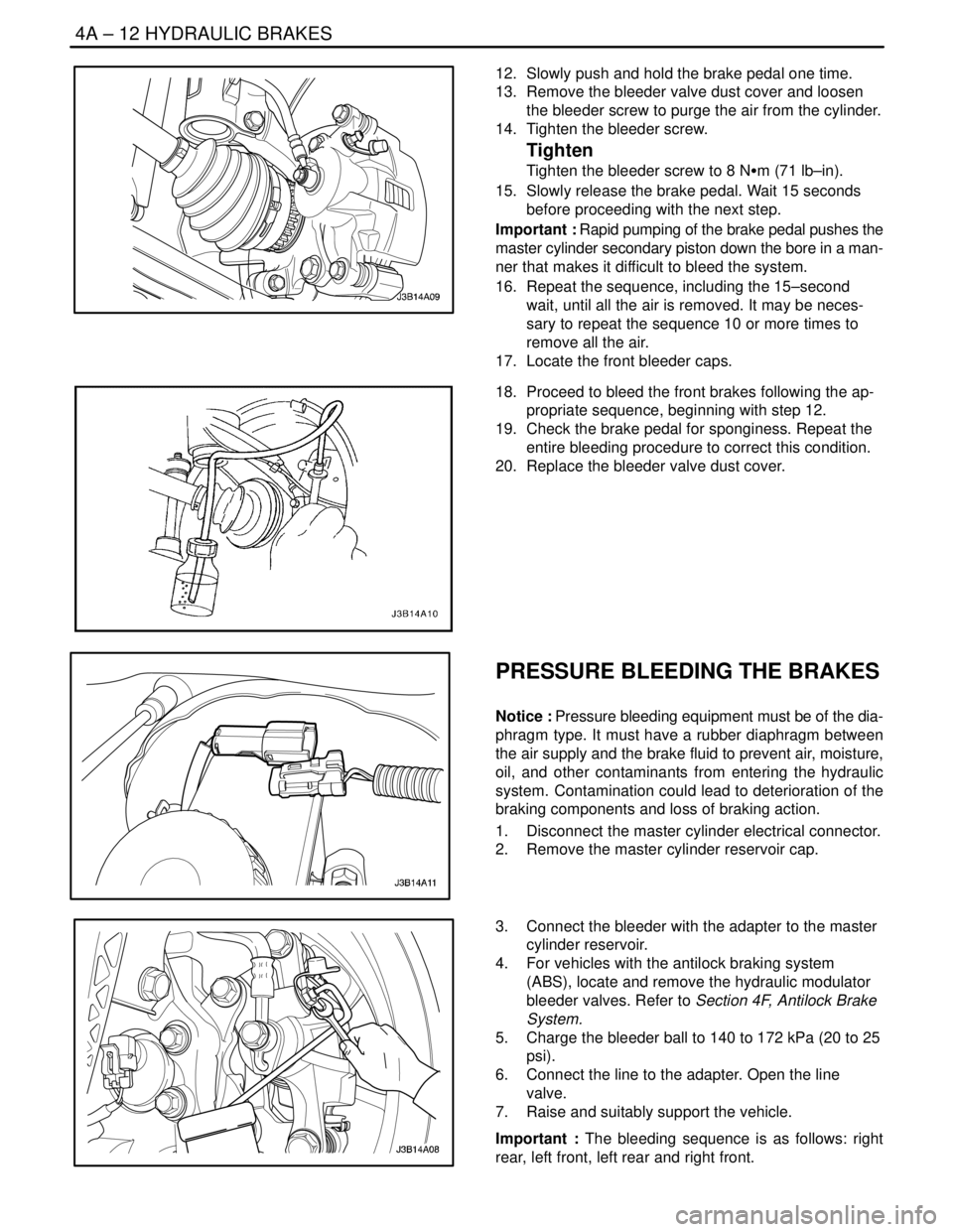Page 1028 of 2643

4A – 12IHYDRAULIC BRAKES
DAEWOO V–121 BL4
12. Slowly push and hold the brake pedal one time.
13. Remove the bleeder valve dust cover and loosen
the bleeder screw to purge the air from the cylinder.
14. Tighten the bleeder screw.
Tighten
Tighten the bleeder screw to 8 NSm (71 lb–in).
15. Slowly release the brake pedal. Wait 15 seconds
before proceeding with the next step.
Important : Rapid pumping of the brake pedal pushes the
master cylinder secondary piston down the bore in a man-
ner that makes it difficult to bleed the system.
16. Repeat the sequence, including the 15–second
wait, until all the air is removed. It may be neces-
sary to repeat the sequence 10 or more times to
remove all the air.
17. Locate the front bleeder caps.
18. Proceed to bleed the front brakes following the ap-
propriate sequence, beginning with step 12.
19. Check the brake pedal for sponginess. Repeat the
entire bleeding procedure to correct this condition.
20. Replace the bleeder valve dust cover.
PRESSURE BLEEDING THE BRAKES
Notice : Pressure bleeding equipment must be of the dia-
phragm type. It must have a rubber diaphragm between
the air supply and the brake fluid to prevent air, moisture,
oil, and other contaminants from entering the hydraulic
system. Contamination could lead to deterioration of the
braking components and loss of braking action.
1. Disconnect the master cylinder electrical connector.
2. Remove the master cylinder reservoir cap.
3. Connect the bleeder with the adapter to the master
cylinder reservoir.
4. For vehicles with the antilock braking system
(ABS), locate and remove the hydraulic modulator
bleeder valves. Refer to Section 4F, Antilock Brake
System.
5. Charge the bleeder ball to 140 to 172 kPa (20 to 25
psi).
6. Connect the line to the adapter. Open the line
valve.
7. Raise and suitably support the vehicle.
Important : The bleeding sequence is as follows: right
rear, left front, left rear and right front.
Page 1029 of 2643
HYDRAULIC BRAKES 4A – 13
DAEWOO V–121 BL4
8. Attach the bleeder hose to the bleeder valve. Sub-
merge the opposite end of the hose in a clean con-
tainer partially filled with brake fluid.
9. Open the bleeder valve one–half to three–fourths
turn and allow the fluid to flow until no air is seen in
the fluid.
Notice : After the bleeding operation, the brake reservoir
may be pressurized. While disconnecting the bleeder
hose or the unthreaded adapter cap, cover the cap and the
connection with a shop towel to protect painted surfaces
from contact with the brake fluid.
10. Inspect the brake pedal for sponginess. Repeat the
entire bleeding procedure to correct this condition.
BRAKE HOSE REAR
Removal Procedure
1. Raise and suitably support the vehicle.
2. Remove the brake hose retainer.
3. Disconnect the brake pipe line from the disc brake
hose.
4. Remove the rear disc brake hose retainer and the
brake hose from the bracket on the steering
knuckle shaft.
Page 1033 of 2643
HYDRAULIC BRAKES 4A – 17
DAEWOO V–121 BL4
GENERAL DESCRIPTION
AND SYSTEM OPERATION
WARNING LAMP OPERATION
This brake system uses a BRAKE warning lamp located
in the instrument panel cluster. When the ignition switch
is in the START position, the BRAKE warning lamp should
illuminate. It should go off when the ignition switch returns
to the ON position.The following conditions will activate the BRAKE warning
lamp:
S The lamp should be on whenever the parking brake
is applied and the ignition switch is in the ON posi-
tion.
S A low fluid level in the master cylinder will turn the
BRAKE lamp on.
Page 1034 of 2643

SECTION : 4B
MASTER CYLINDER
TABLE OF CONTENTS
SPECIFICATIONS4B–1 . . . . . . . . . . . . . . . . . . . . . . . . . .
Fastener Tightening Specifications 4B–1. . . . . . . . . .
DIAGNOSIS4B–2 . . . . . . . . . . . . . . . . . . . . . . . . . . . . . . . .
Checking Brake Proportioning Valve 4B–2. . . . . . . . .
MAINTENANCE AND REPAIR4B–3 . . . . . . . . . . . . . . .
ON–VEHICLE SERVICE 4B–3. . . . . . . . . . . . . . . . . . . . .
Master Cylinder Assembly 4B–3. . . . . . . . . . . . . . . . . . Brake Fluid Reservoir 4B–4. . . . . . . . . . . . . . . . . . . . . .
UNIT REPAIR 4B–7. . . . . . . . . . . . . . . . . . . . . . . . . . . . . .
Master Cylinder Overhaul 4B–7. . . . . . . . . . . . . . . . . . .
GENERAL DESCRIPTION AND SYSTEM
OPERATION4B–9 . . . . . . . . . . . . . . . . . . . . . . . . . . . . . .
Master Cylinder 4B–9. . . . . . . . . . . . . . . . . . . . . . . . . . .
Fluid Level Sensor 4B–9. . . . . . . . . . . . . . . . . . . . . . . .
SPECIFICATIONS
FASTENER TIGHTENING SPECIFICATIONS
ApplicationNSmLb–FtLb–In
Brake Lines1612–
Master Cylinder Attaching Nuts1813–
Proportioning Valves2216–
Page 1036 of 2643
MASTER CYLINDER 4B – 3
DAEWOO V–121 BL4
MAINTENANCE AND REPAIR
ON–VEHICLE SERVICE
MASTER CYLINDER ASSEMBLY
(Left–Hand Drive Shown, Right–Hand Drive
Similar)
Removal Procedure
1. Disconnect the electrical connector from the reser-
voir.
2. For vehicles with the ABS braking system, discon-
nect the brake lines from the master cylinder body.
3. For vehicles with the non–ABS braking system, dis-
connect the brake lines from the proportioning
valves.
4. For vehicles with the manual transaxle, disconnect
the clip to the clutch hose connection to the master
cylinder and move the clip out of the way.
5. Remove the clutch hose from the master cylinder if
equipped.
6. Plug the opening to the brake lines to prevent fluid
loss and contamination.
7. Remove the attaching nuts from the power booster.
8. Remove the master cylinder assembly.
9. Drain the brake fluid.
Page 1037 of 2643
4B – 4IMASTER CYLINDER
DAEWOO V–121 BL4
Installation Procedure
1. Install the master cylinder assembly with the new
attaching nuts.
Tighten
Tighten the master cylinder attaching nuts to 18 NSm
(13 lb–ft).
2. For vehicles with the ABS braking system (as
shown), connect the brake lines to the cylinder
body.
3. For vehicles with the non–ABS braking system,
connect the brake lines to the proportioning valves.
Tighten
Tighten the brake lines to 16 NSm (12 lb–ft).
4. For vehicles with the manual transaxle, connect the
clip to the clutch hose connection to the master cyl-
inder reservoir if equipped.
5. Connect the electrical connector.
6. Add brake fluid.
7. Check for leaks and recheck the fluid level.
8. Bleed the brake system. Refer to Section 4A, Hy-
draulic Brakes.
BRAKE FLUID RESERVOIR
Removal Procedure
Important : Remove the reservoir only when replacing a
damaged or a leaking reservoir.
1. Disconnect the electrical connector from the reser-
voir.
Page 1038 of 2643
MASTER CYLINDER 4B – 5
DAEWOO V–121 BL4
2. For vehicles with the manual transaxle, disconnect
the clip to the clutch hose connection to the master
cylinder, and move the clip out of the way.
3. Remove the clutch hose from the master cylinder.
4. Gently pry upwards with a screwdriver to release
the reservoir.
5. Tilt the reservoir and pull it upward in order to re-
move it.
6. Remove the reservoir seals from the master cylin-
der body.
Installation Procedure
1. Lubricate the new seals with clean brake fluid.
Install the seals into the cylinder body.
2. Install the reservoir on the master cylinder body.
3. For vehicles with the manual transaxle, connect the
clip to the clutch hose connection to the master cyl-
inder.
Page 1039 of 2643
4B – 6IMASTER CYLINDER
DAEWOO V–121 BL4
4. Add brake fluid.
5. Raise and suitably support the vehicle.
6. Bleed the braking system. Refer to Section 4A, Hy-
draulic Brakes orSection 4F, Antilock Brake Sys-
tem.Bleed the clutch master cylinder. Refer to Sec-
tion 5C, Clutch.
7. Lower the vehicle.
8. Connect the reservoir electrical connector.